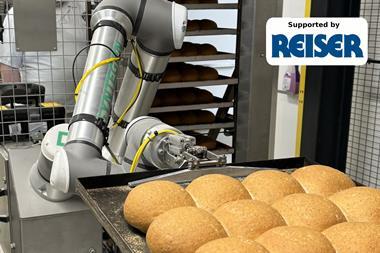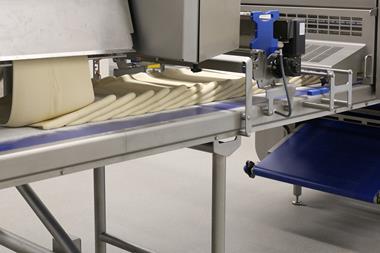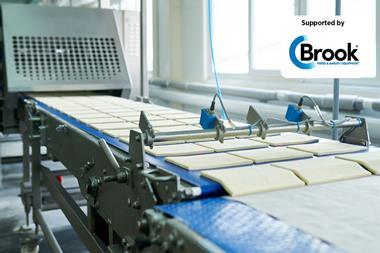Growing consumer interest in healthier and artisan-style products has brought demand for more versatile dough handling equipment
When it comes to consistently producing a quality loaf, bakers need equipment that treats dough with the care and respect it deserves.
As every baker knows, handle dough in the wrong way and the results won’t be pretty – or particularly tasty.
Baking industry research into dough rheology has shown gentle dough handling is the key factor in improving loaf quality, according to Baker Perkins.
“The gas cell structure created in the mixer must be carefully preserved throughout the forming process,” Keith Graham, marketing manager at Baker Perkins, tells British Baker. “The more gently dough is treated, the higher the cell count – that is, the number of micro-bubbles retained in the dough structure. The effect is to create a loaf with a finer crumb structure that is more resilient and has a better colour.”
In the case of its Accurist 2.1 dough divider, Baker Perkins introduced servo control to the ram motion, permitting low-pressure operation that it says minimises shear, compression and ram movement. This reduces pressure on the product and limits dough stress, says the manufacturer, resulting in benefits including up to a 15% increase in cell count, up to a 20% increase in softness, greater volume, improved crumb development and a better colour.
Bakers and equipment suppliers must also factor in growing consumer hunger for a wider range of breads – particularly artisan-style loaves – making the demands on dividers and moulders greater than ever.
“With developing customer demand for more interesting and healthier products, such as seeded loaves, gluten-free breads and speciality fruited buns, equipment also needs to be extremely versatile to cope with all types of mixes, from doughnuts to bagels, rolls to tortillas, focaccias to flatbreads,” says Nick Lacey, MD at Dowson Food Machinery, which supplies a range of dividers.
He adds that features key to successful gentle dough handling include a proven suction system and consistent high-quality and accurately weighted dough balls.
Dowson supplies dividing and moulding kit that can achieve outputs of up to 30,000 units per hour, speeds of up to 50 strokes per minute, with up to 12 lanes, and a wide weight handling range from 20g to 250g.
“As well as being able to gently handle such a wide range of breads, this machine also has the capability to deal with fruited and high percentage sponge doughs.
A flour duster option can be deployed on the divider outfeed to ‘top’ or dust the dough balls. Finger bands can also be adjusted to optimise the proving operation.”
Reiser, which produces single-outlet and multi-outlet dividers, says the heart of its equipment is its pumping element – a double-screw transport system.
“The powerful, positive-displacement double-screw is unique for its gentle and consistent handling of the dough without overworking it... as well as exact-weight dough portions,” says the manufacturer. “The double-screw is available in a variety of configurations to accurately portion virtually any type of dough.”
David Marsh, director at Kaak Group UK, previously known as Benier UK, points out the highest-volume systems, such as those using Chorleywood Bread Process (CBP) doughs, emphasise efficiency and demand accurate dividing.
“Even here, dough damage during dividing can be reduced to a minimum by controlling the various pressures exerted on the dough,” says Marsh, adding that the Kaak Group’s Benier Dough Master achieves this by using servo drives to respond to back pressures exerted by the dough during dividing and limit the overall force applied.
When it comes to sheeting, rolling and moulding CBP doughs, it is important not to tear the dough during the sheeting process, he adds.
“We give the dough time to ‘flow’ even when moulding at rates of many thousands of units per hour,” says Marsh. “The sheeted width should be a little short of the final moulded length, or we risk damage trying to confine the dough length when moulding.”
A different approach is required for artisanal products made from processes using sourdoughs, sponges or fermentation periods that will give a dough with a “gassiness” that is a prime contributor to the characteristics of the final bread.
Marsh says artisanal dough dividing and handling requires expert knowledge to ensure the equipment meets the product’s needs, and it’s not a matter of buying off-the-shelf kit.
“The demands of the whole dough handling system have to be carefully considered,” he adds. “How dough is extracted from its mixing bowl and handled at each step in the process influences the final product, its texture and its uniformity of quality, even if it cannot reach the levels of uniform shape and weight found in a CBP product.”
Kaak Group’s DrieM 6 roll sheeting system can handle artisanal doughs by using a roll system that self-adjusts to the dough being fed to it.
“With the rise in demand for more artisanal doughs, the development of sheet and form processes for bread doughs has had to keep pace,” he adds.
“It is here that the development of bread dough sheeting technology has evolved out of what were once, basically, pastry sheeting technologies.”
Handling seeds and inclusions
Demand for seeded products – particularly those enrobed in seeds – has led to further developments by moulder suppliers.
Baker Perkins, for example, has introduced two innovations for its Multitex4 bread moulder (pictured) that can fully enrobe loaves with seeds or grains, and create attractive swirled loaves.
To fully enrobe a loaf, the machine rolls the coiled piece in seeds or grains before panning.
“This achieves good coverage and simultaneously solves the problems of pressing the seeds into the dough piece, and avoiding waste,” says Keith Graham, marketing manager at Baker Perkins. “Metered quantities are deposited on the moulding conveyor to be picked up and lightly pressed into the surface of the dough piece as it rotates under the moulding board. There is no waste, and any leftover seeds drop into the pan with the dough piece.”
The second innovation intersperses inclusions with the coils of dough, which the manufacturer says creates a much more visually interesting product with an intense flavour hit.
Kaak Group’s Benier offers versions of its moulders where seeds can be added prior to curling, which produces a “swiss roll” effect within the dough piece. However, it also offers versions where the seeds may be added after curling to be moulded into the outer skin of the dough piece.
“Inclusions added during mixing offer differing challenges depending upon inclusion type,” says David Marsh, director at Kaak Group UK. “The usual challenge with seeds added during mixing is their affinity to water, which continues after mixing to ‘modify’ the dough rheology through the make-up process.”
Maintaining maintenance
Regular maintenance and servicing can greatly extend the life of equipment, according to Steve Merritt, managing director at EPP.
His firm has recently replaced a divider/rounder that was approaching 35 years old and had been producing 18,000 dough pieces an hour, day-in, day-out at a central bakery at one of the UK’s leading retail bakery chains.
“Properly looked after and regularly serviced, this is the life expectancy bakers can expect from a quality manufacturer,” adds Merritt.
“It is important to properly clean the machine after every shift. If you properly maintain the machine and have it regularly serviced, then there is no reason it will not reliably produce consistent dough pieces for more than 35 years.”
Case study: Dwyers Bakery
Equipment manufacturer Newsmith Stainless has been supplying dough dividers to bakeries around the UK for the past 40 years.
Its clients include Greggs, Coghlan’s in Ireland, GH Brownings in Scotland and JG Fletcher & Son in Wigan, while Sheldon’s in Manchester recently purchased five Newsmith Stainless machines.
Newsmith also supplies Dwyers Bakery in Rugby, Midlands, which was purchased by John Dwyer in 1989 when it was an operation with a handful of accounts, making just £27,000 a year.
As the wholesale business began to grow, Dwyer took the decision to close the shop and concentrate on providing quality bread and cakes. The move turned the business around; it has expanded four times to keep up with demand, and now makes £2m a year.
“With new investment in our staff and the equipment we use, we have set our sights on taking the business to the next level,” says Dwyer.
His bakery’s equipment includes a two-pocket Oddy brand divider, bought for around £32,000.
“It makes me smile every day when I come to work,” says Dwyer. “It is serviced every year and still runs after purchasing it 15 years ago. It has been a big part of where we are as a business today compared to when I first bought the business in 1989.”
The bakery also recently invested £100,000 in a six-pocket divider from Newsmith under the same brand (pictured above). It includes an intermediate prover and pressure boards that can produce any type of shaped roll.
“We can make a 32kg mix in the six-pocket divider and produce 10,800 rolls an hour at only 65% capability of the machine,” Dwyer tells British Baker. “The two-pocket can produce around 3,000 rolls an hour.
“They are fantastic and are the best machines that we have ever bought from Newsmith.”
...
Dwyer’s Bakery galleryCase study: Dwyer’s Bakery for Dividers & Moulders featureoriginaldate 1/1/0001 6:00:00 AMwidth 1024height 768originaldate 1/1/0001 6:00:00 AMheight 768width 1024orientation 1camerasoftware Adobe Photoshop CC 2originaldate 1/1/0001 6:00:00 AMheight 768width 1024orientation 1camerasoftware Adobe Photoshop CC 2originaldate 1/1/0001 6:00:00 AMheight 768width 1024orientation 1camerasoftware Adobe Photoshop CC 2originaldate 1/1/0001 6:00:00 AMwidth 1024height 768

























No comments yet